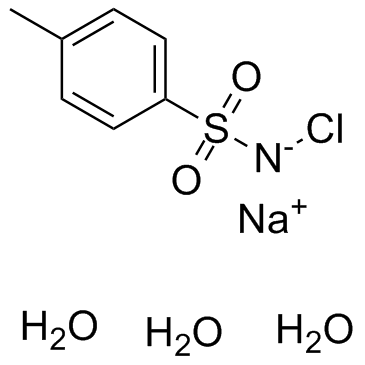Tosylchloramide sodium trihydrate |
| Catalog No.GC32363 |
Le tosylchloramide sodique trihydraté (chloramine T sodique trihydraté) est un agent désinfectant largement utilisé dans les laboratoires, les cuisines et les hÔpitaux.
Products are for research use only. Not for human use. We do not sell to patients.

Cas No.: 7080-50-4
Sample solution is provided at 25 µL, 10mM.
Tosylchloramide sodium trihydrate (Chloramine T sodium trihydrate) is a disinfectant agent widely used in laboratories, kitchens and hospitals. It is also used as a biocide in air fresheners and deodorants.
Gram-positive growth is reduced by 95% to 100% after tosylchloramide treatment, regardless of dose, with or without serum. E coli (gram-negative; with/without serum) is reduced 94% to 100% at antiseptic concentrations of 300 and 400 ppm. At 200 ppm, E coli growth is fully inhibited without serum present and by 50% with serum. At 100 and 200 ppm, cell viability remains greater than 90% under all experimental conditions. A 300-ppm, 3-minute exposure to tosylchloramide results in cell viability of up to 70%, with longer exposures producing lower viabilities. Serum does not affect cell viability in any condition[1].
A dose-dependently significant DNA damage in the rat tissues and inflammation is histopathologically noted around the terminal airways of the lung in both male and female rats[2]. The 24-h exposure to 50 mg/L of chloramine-T is toxic for crayfish and leads to substantial loss of energy that became apparent during subsequently conducted physical stress[3]. Tosylchloramide may potentiate the toxicity of many xenobiotics via metabolic activation and/or accumulation of reactive metabolites. The activities of CYP2E1, CYP1A1/2 CYP2B1/2, CYP3A4 and CYP4A1/2 enzymes significantly increase after treatment with 2.50, 5 and 10 mg/kg bw/day tosylchloramide, in a dose-dependent manner. This effect is not observed after tosylchloramide treatment at dose of 1.25 mg/kg bw/day[4].
[1]. Kloth LC, et al. Bactericidal and cytotoxic effects of chloramine-T on wound pathogens and human fibroblasts in vitro. Adv Skin Wound Care. 2007 Jun;20(6):331-45. [2]. Shim I, et al. Inhalation exposure to chloramine T induces DNA damage and inflammation in lung of Sprague-Dawley rats. J Toxicol Sci. 2013;38(6):937-46. [3]. Kuklina I, et al. Investigation of chloramine-T impact on crayfish Astacus leptodactylus (Esch., 1823) cardiac activity. Environ Sci Pollut Res Int. 2014 Sep;21(17):10262-9. [4]. Martínez MA, et al. Induction of cytochrome P450-dependent mixed function oxidase activities and peroxisome proliferation by chloramine-T in male rat liver. Food Chem Toxicol. 2017 Aug;106(Pt A):86-91.
Average Rating: 5 (Based on Reviews and 25 reference(s) in Google Scholar.)
GLPBIO products are for RESEARCH USE ONLY. Please make sure your review or question is research based.
Required fields are marked with *




















